 Athens to Nafplion is an easy 2 hours. The roads are good, the traffic manageable and the drive was without incident; well, we did almost run out of gas and had to coast down a few hills for 2-3 kilometers before we found a gas station.
Athens to Nafplion is an easy 2 hours. The roads are good, the traffic manageable and the drive was without incident; well, we did almost run out of gas and had to coast down a few hills for 2-3 kilometers before we found a gas station.
We are truly in the land of the gods. Unlike the loud tourist islands or the chaos of Athens, Peloponesse is quiet and incredibly beautiful, filled with picturesque Greek villages, thousands of years of history and miles of grape and olive vineyards. This is where the Greeks spend their holidays. How refreshing to get away from the tour groups.
The Peloponesse is named after Pelops, the son of Tantalus and grandfather of the House of Atreus, the most dysfunctional and cursed family in known history.
Like the many before us, we’ve come to search out more about Greek Mythology, Homer’s Epic and the Curse of the House of Atreus. Everyone knows a little about the Iliad and the Odyssey, at least the latest Hollywood version, some have seen or read something about Agamemnon, Helen of Troy or Electra. You can enjoy this country without knowing the story, but once you know the mythology, the visit is so much more exciting.
For those who don’t know about the curse, I’ve compiled a brief synopsis based on Mythological lore, rumors and a play by Euripides, who my brother David refers to as the “father of passing gas”.
1 – Tantalus pisses off the gods by stealing some sacred food. He tries to make amends by cooking them a tasty stew. However, the main ingredient is his son Pelops, all chopped up and boiled.
2 – The (know-all) gods put Pelops back together and punish Tantalus by making him stand in a pool of water beneath a fruit tree. If he reaches for the fruit, the branches lift the fruit away. If he bends down to get a drink, the water recedes. It’s an eternity of starvation and thirst.
3 – The god Hephestus take a shine to Pelops and teaches him to become a great charioteer. Pelops is challenged to a chariot race by King Oenomaos of Olympias. If he wins, he gets the Kings’ daughter, Hippodamia. If he loses, his skull joins the rest of the losers as the foundation of the King’s temple.
4 – Myrtilos, the King’s charioteer helps Pelops to win the race by sabotaging the chariot of the Oenomaos. His payment for helping Pelops is a night with Hippodamia.
5 – Pelops wins the race and Oenomaos is killed by his sabotaged chariot. When Myrtilios tries to collect his night with Hippodamia, Pelops throws him off the mountain. As he falls to his death, Myrtilos curses Pelops and all his offsprings. (And so the curse begins)
6 – Pelops marries Hippodamia and they have lots of children. Among the boys are Atreus, his twin brother Thyestes and Pelop’s favorite, Chrysippus. Amongst the daughters is Eurydice who marries Perseus (the guy who killed Medusa) and gives birth to Alcmene the mother of Hercules.
7 – Atreus and Thyestes kill Chrysippus and are exiled to Mycenae. Hippodamia goes mad with grief and hangs herself.
8- Atreus is crowned King of Mycenae. I’ll explain this a little later down the post.
9 – Atreus marries Aerope and fathers Menalaus and Agamemnon.
10 – Aerope leaves Atreus for his brother Thyestes, who not only gets his wife but also his throne.
11 – Atreus then kills the sons of Thyestes, chops them up into a stew (everything but the hands and feet) and serves it to his brother, while waving their little hands and feet at him.
12 – Thyestes curses the House of Atreus. And now it really gets bad.
13 – On the advice of an oracle, Thyestes seduces his daughter Pelopia to produce the son who will avenge him. Pelopia gives birth to Aegisthus.
14 – Aegisthus, runs away from home after finding out his sister is his mother but fulfills the Oracle’s prophecy when he kills Atreus by mistake.
15 – Meanwhile nearby, Zeus rapes Leda the Swan and Helen hatches from the egg.
16 – Helen grows to be the most beautiful woman in the world and after hundreds of suitors, she marries Menalaus , the son of Atreus.
17 – Agamemnon, the other son of Atreus and brother of Menalaus marries Clytaemnestra, the sister of Helen. Their children include Iphigenia, Electra, and Orestes.
18 – Meanwhile in a grove nearby, the goddess Aphrodite bribes Paris with Helen as a reward if he picks her as the winner of a beauty contest. Paris says Aphrodite is the most beautiful and takes Helen to his home in Troy.
19 – Menalaus and Agamemnon declare war on Troy.
20 – Agamemnon can’t catch a good wind to get the troops to sail so he consults an Oracle who tells him to sacrifice his daughter, Iphegenia. He kills his daughter, the winds come and 1186 ships with 100,000 men sail for Troy.
21 – With Agamemnon gone, Clytaemnestra takes Aegisthus as her lover. Aegisthus (you remember) is the son of Thyestes, cousin and uncle of Agamemnon and murderer of Atreus.
22 – Agamamenon comes back from Troy with his new love Cassandra but after the welcome feast, Clytaemnestra and Aegisthus kill them in the bath tub.
23 – Electra mourns the death of her father and becomes obsessed with vengeance. She convinces her brother Orestes to help her kill Clytaemnestra and Aegisthus.
24 – Electra and Orestes kill Clytaemnestra and Aegisthus and everything else in the Palace, household slaves, horses, dogs, cats, goats, sheep. Then to cap it all off, they burn the whole place down. It’s a massacre.
25 – A guilt stricken Orestes is pursued by the furies and goes mad…
The story has everything you could ask for, love, war, betrayal, action, drama, tragedy and the supernatural. No wonder it’s been retold and remade into countless plays and films over the past 3,000 years. You can even get a Master’s degree in this stuff. But as much as we’ve read about it, there is absolutely nothing like coming here and reliving the tale.
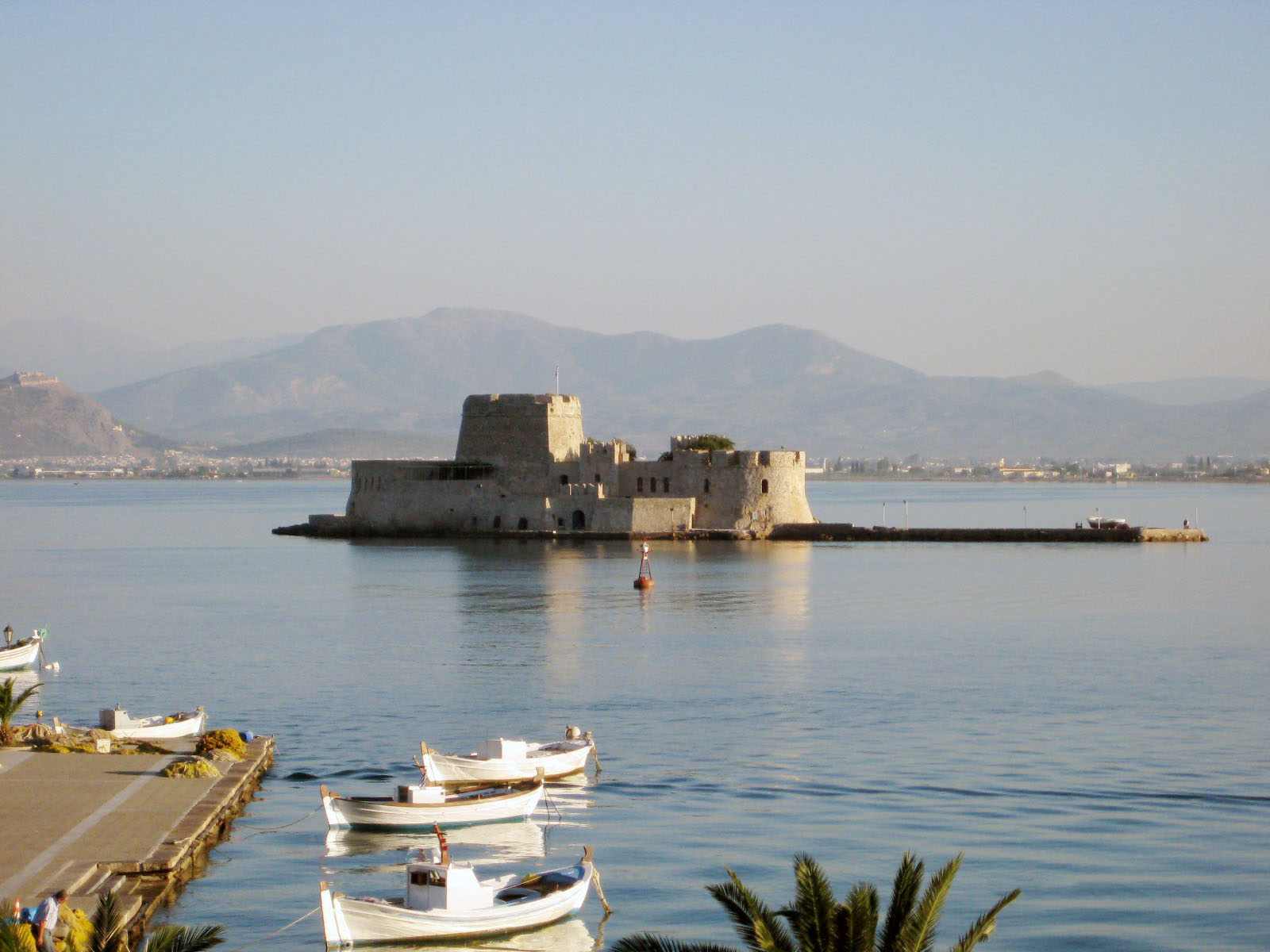 Nafplio
Nafplio
Nafplio, named after the son of Poseidon, is the harbor village of the Argolic Gulf where we’ve made our home while we explore the area. The god of the sea would feel right at home here. This is one of the most unexpected pleasant surprises we’ve had in years.
There’s an old fortress on the hill overlooking the harbor called Arkonafplio. The fortifications go back to the 3rd century BC, and were reinforced up till the 14th century. These days most of it has been converted in the luxury Nafplio Palace Hotel.
The Venetians added the little harbor fortress called Bourtzi in the 15th century and chained off the harbor. It was known as Porto Cadenza (Port of Chains) back then. But, apparently, the two fortresses of defense weren’t enough. When the Venetians got the harbor back from the Turks in the late 17th century, they reinforced the massive Palamidi Fortress up on the highest hill overlooking the Argolic Gulf. It was enough to keep the Turks away for good. or at least till now.
Palamidi, by the way, was the son of Nafplio.
In 1822, this beautiful village became the capital city of Greece. But in 1834 the Royal Family decided to end their 12 year holiday in this beautiful town and go where the action was. They moved the capital back to Athens.
Our hotel room looks out over the harbor and the 15th century Bourtzi Castle. It’s really cute and not very foreboding. When the Ottomans were here, they used the Bourtzi as a retirement home for the Palamidi executioners. The royal henchmen didn’t feel very safe living alongside a village population who’s family members had been whacked with his axe.
When the Greeks took it back, the Bourtzi kept it’s tradition as the Executioner’s apartments, but they also made life a little easier for him. Instead of summoning the executioner from Bourtzi to Palamidi Fortress, they moved the executions down to the Bourtzi Castle.
From 1930 to 1970 it was a hotel, and not just for vacationing executioners. Now, it’s mainly a tourist attraction, occasionally hosting parts of the Nafplion Summer Music Festival. Boats cruise out to it all day long. The boat waits for 15 minutes, the tourist climb around and the boat goes back to shore. We sit on our balcony and watch them come and go. I can’t think of anything more entertaining and relaxing.
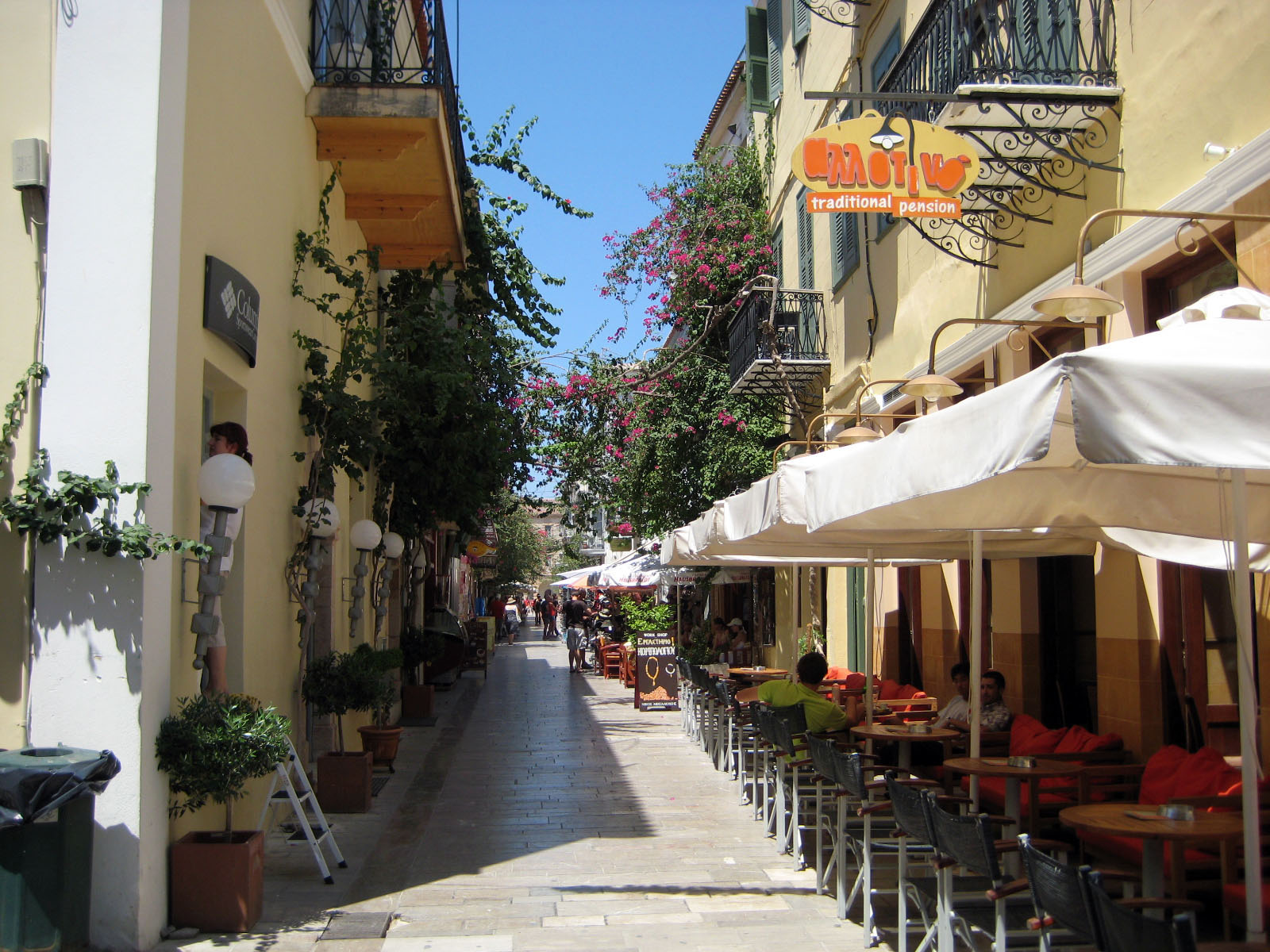 Nafplio is one of those perfect seaside villages waiting to get plotted by cruise ships and massive tourism. The small pedestrian streets lined with artisan crafts and cafes, and the harbors lined with restaurants serving the fresh catch of the day might enjoy the increase the business, but then again, the Greeks are particular about how much they’re willing to work. In the summertime, they open around 9am or 10am and then close around 12noon. Some stay closed till 6 or 7pm and then open back up till 11pm. Others will choose whatever hours they want to work, depending on how they feel. It goes on like this all year round. It’s Greece. We can’t believe a place like this still exists in this world?
Nafplio is one of those perfect seaside villages waiting to get plotted by cruise ships and massive tourism. The small pedestrian streets lined with artisan crafts and cafes, and the harbors lined with restaurants serving the fresh catch of the day might enjoy the increase the business, but then again, the Greeks are particular about how much they’re willing to work. In the summertime, they open around 9am or 10am and then close around 12noon. Some stay closed till 6 or 7pm and then open back up till 11pm. Others will choose whatever hours they want to work, depending on how they feel. It goes on like this all year round. It’s Greece. We can’t believe a place like this still exists in this world?
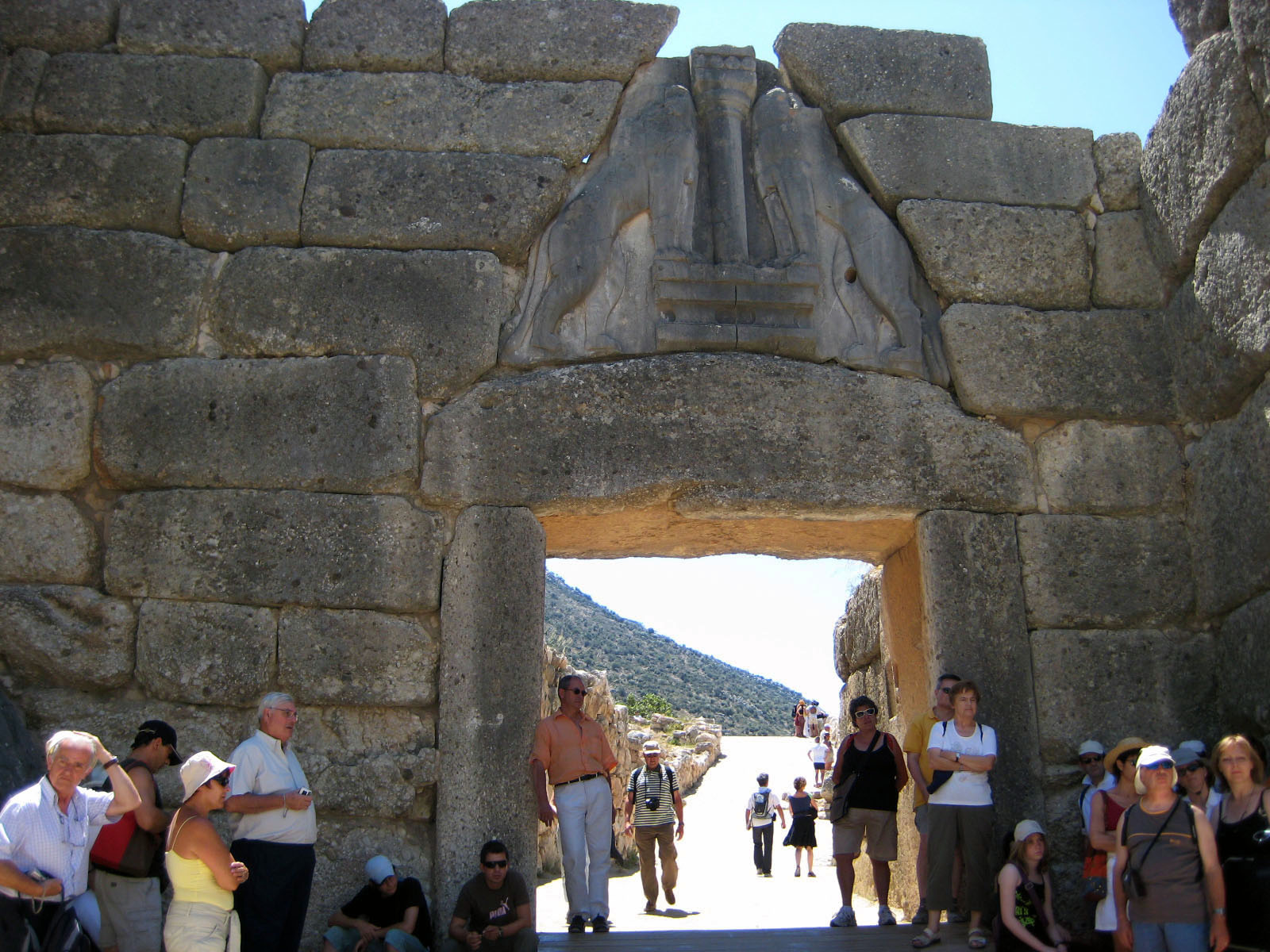 Mycenae – Birthplace of Hercules, home to the House of Atreus
Mycenae – Birthplace of Hercules, home to the House of Atreus
Our first road trip was to Mycanae, the ancient city of Hercules and the House of Atreus.
Most of the site is worn down to the foundations but it still contains the remains of one of the greatest stories every told.
From the moment we drove up to the main entrance our imaginations went wild. Sometime around 1400BC, Perseus (the same one who killed the gorgon Medusa) discovered a magic mushroom and decided to build this great city on the same location. It must have been a pretty potent mushroom. The site of the city is way up on top of the hills.
In order to build a strong fortification around the city he called the one eyed giant Cyclops to build the walls of the fortress. The photo at the top of the page is the Cyclopian Wall.
We don’t really know if the Cyclops did in fact build the walls but each boulder in the walls weights about 6 tons on average. The walls are close to 15’ thick. If the Cyclops didn’t build them, they sure had some amazing construction methods.
In order to get an understanding of the story here, I’ll try to cliff-note the following. Greek myth can sometime get a bit confusing.
- Perseus marries Eurydice, daughter of Pelops (the guy who killed Medusa the Gorgon) and they have a daughter, Alcmene.
- Alcmene gets impregnated up by Zeus and gives birth to Hercules.
- Zeus wants Hercules to be the King of Mycenae but Hera (wife of Zeus) is pissed off at her husband for his affair with Alcmene.
- Hera keeps Hercules in Alcmene’s womb long enough to put his cousin Eurytheus on the throne, which pisses of Zeus. These two fought just like mortal husbands and wives.
- Hercules wants the throne. It’s rightfully his, but his cousin, Eurytheus says he’ll only give it o him if he completes 12 “Herculean tasks”. Hercules should have just thrown Eurytheus off the mountain. He was strong, but maybe not that smart. And so Hercules spends his life completing the labors and never does become King of Mycenae.
- However, some years later, a few of the sons of Hercules join together and kill Eurytheus, but somehow none of the sons get to be King. Maybe they weren’t too smart either.
- The crown, by default, goes to Atreus, the son of Pelops, the other divine line of Mycenae. Remember, Perseus, the founder of the city was married to Eurydice, the daughter of Pelops.
- Once Atreus is on the throne, the curse starts to unfold. (see above )
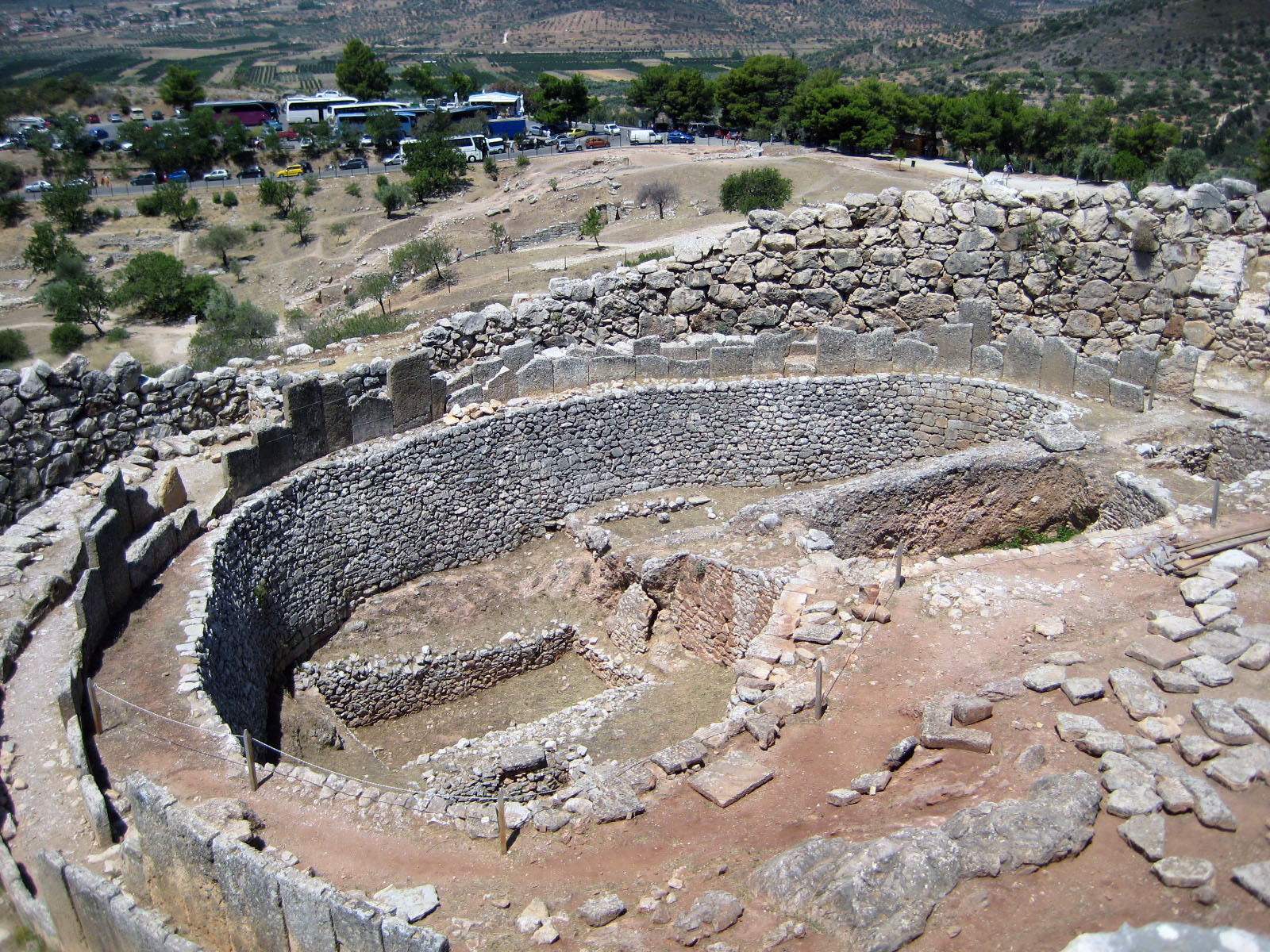 Archaeologist date Mycenae back to 4,000 BC. When Heinrich Schliemann, the Indiana Jones of the late 19th century, discovered the three large circular gravesites one the site, he was certain he uncovered the proof of Homer’s epic. Instead he found something much older. Some of the graves held 3,000 year old ostrich eggs from Egypt and 4,000 year old artifacts from ancient Minoan cultures.
Archaeologist date Mycenae back to 4,000 BC. When Heinrich Schliemann, the Indiana Jones of the late 19th century, discovered the three large circular gravesites one the site, he was certain he uncovered the proof of Homer’s epic. Instead he found something much older. Some of the graves held 3,000 year old ostrich eggs from Egypt and 4,000 year old artifacts from ancient Minoan cultures.
Schliemann’s crew dug up tablets written in Linear B script, the precursor to the ancient Greek language. This alone was an amazing find, but it wasn’t good enough for Schliemann. They persevered and eventually found the the magnificent golden jewelry they were looking for (about 30 pounds of it). An amazing find, especially given that there are no signs that the ancient Mycenaens ever had any gold mines.
The Mycenaen culture died off around 1100 BC, around he same time as the end of the Trojan War. It made perfect sense for a poets like Homer to connect this great civilization and one of the greatest Greek Battles of all time together into one whopping tale. It could possibly be the greatest story ever told. It gave the Greeks heroic warriors, evil villains, life lessons and insights to the gods, and a hell of a lot of adventure and entertainment.
We like to imagine Homer wandering from city to city telling the tale. Did he tell the entire story at one time? Did he just tell them one chapter and then return for the next installment a few months later? Did they sell tickets?
Homer created the epic more than 300 years after the fall of both Troy and Mycenae. If his account was taken from survivors, they were handed down to him through 12 generations. That’s a lot of room for revisions.
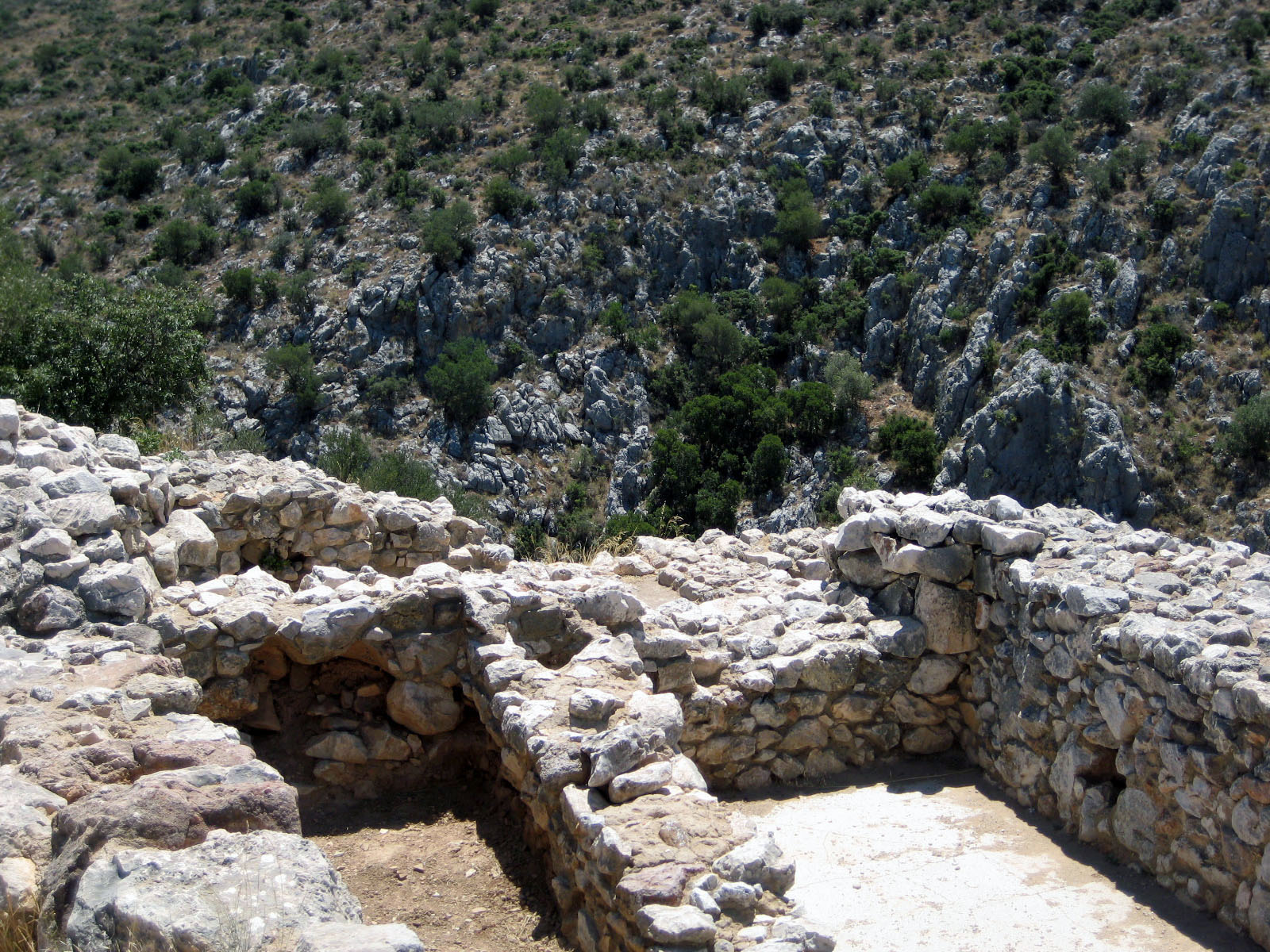 Even if it was just a good piece of fiction, you can’t stop thinking about it as you walk through the remains of this massive city. Is this where Orestes and Electra threw the body of Clytaemnestra off the hill? Is this the bathroom where Agamemnon and Cassandra were killed? There are even “tholos” (beehive) tombs marked off as the tombs of Clytaemnestra and Aegistius. The caretakers of the site really want you to believe. And we do..
Even if it was just a good piece of fiction, you can’t stop thinking about it as you walk through the remains of this massive city. Is this where Orestes and Electra threw the body of Clytaemnestra off the hill? Is this the bathroom where Agamemnon and Cassandra were killed? There are even “tholos” (beehive) tombs marked off as the tombs of Clytaemnestra and Aegistius. The caretakers of the site really want you to believe. And we do..
Just walking through the Lion Gate and looking at the 12 ton lintel that holds the two lions in place is enough to show how much effort was put into building this city, taking every precaution and defense.
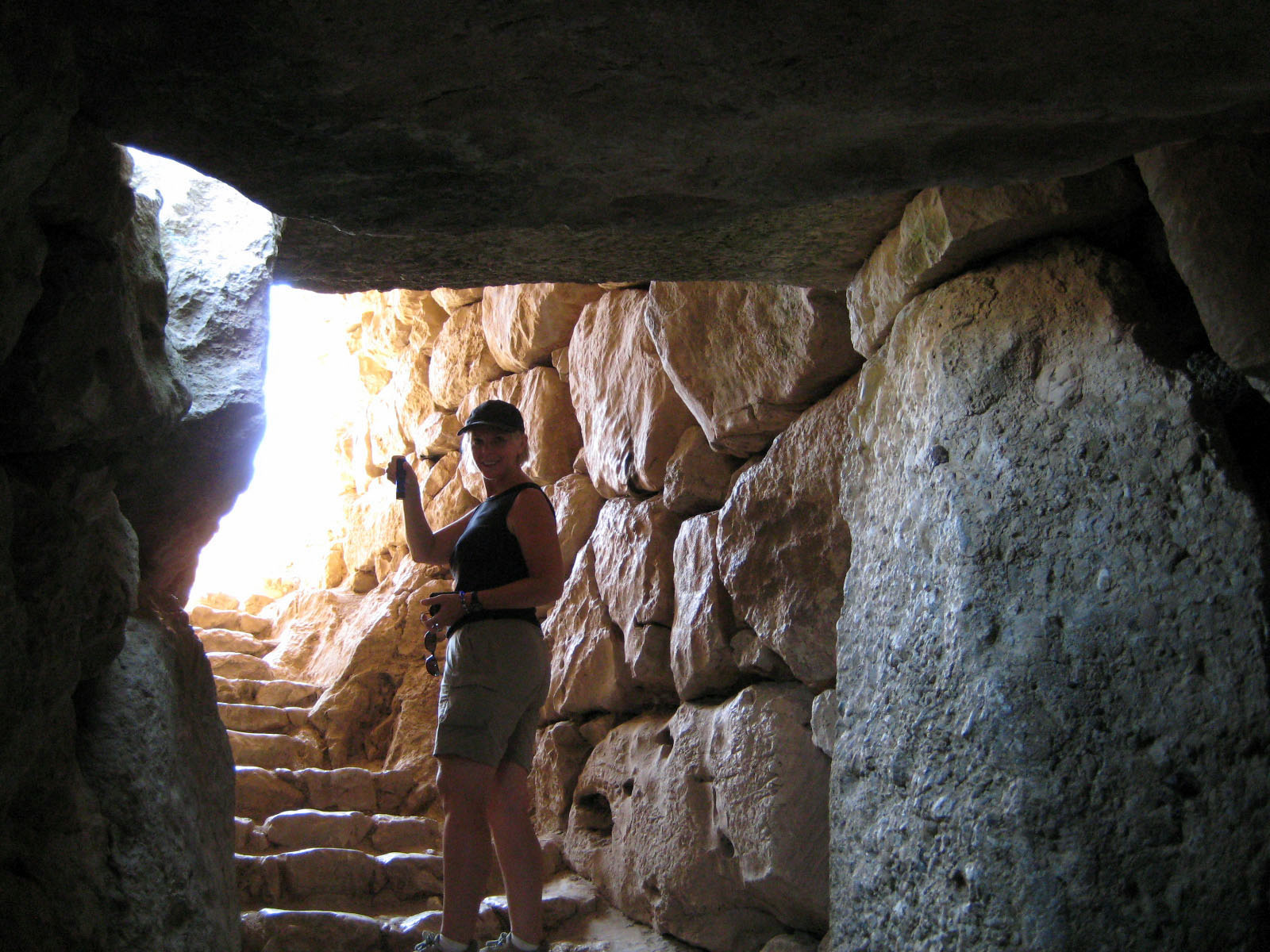 There’s no proof that the city was ever conquered. The Mycenaens took every precaution to protect it, even enclosing their water supply with the Cyclopian walls. In so many other ancient sites subterranean cistern like the one here would be roped off to visitors. This cave was open to all who dare walk down the creepy, pitch-black 85 slippery steps to the ancient water source below.
There’s no proof that the city was ever conquered. The Mycenaens took every precaution to protect it, even enclosing their water supply with the Cyclopian walls. In so many other ancient sites subterranean cistern like the one here would be roped off to visitors. This cave was open to all who dare walk down the creepy, pitch-black 85 slippery steps to the ancient water source below.
Be sure to bring a reliable flashlight or torch and wear good rubber grips on your feet. We went down with a gaggle of French tourists who were constantly asking, ”is this the way out?” It wasn’t the way out. It was the way down!
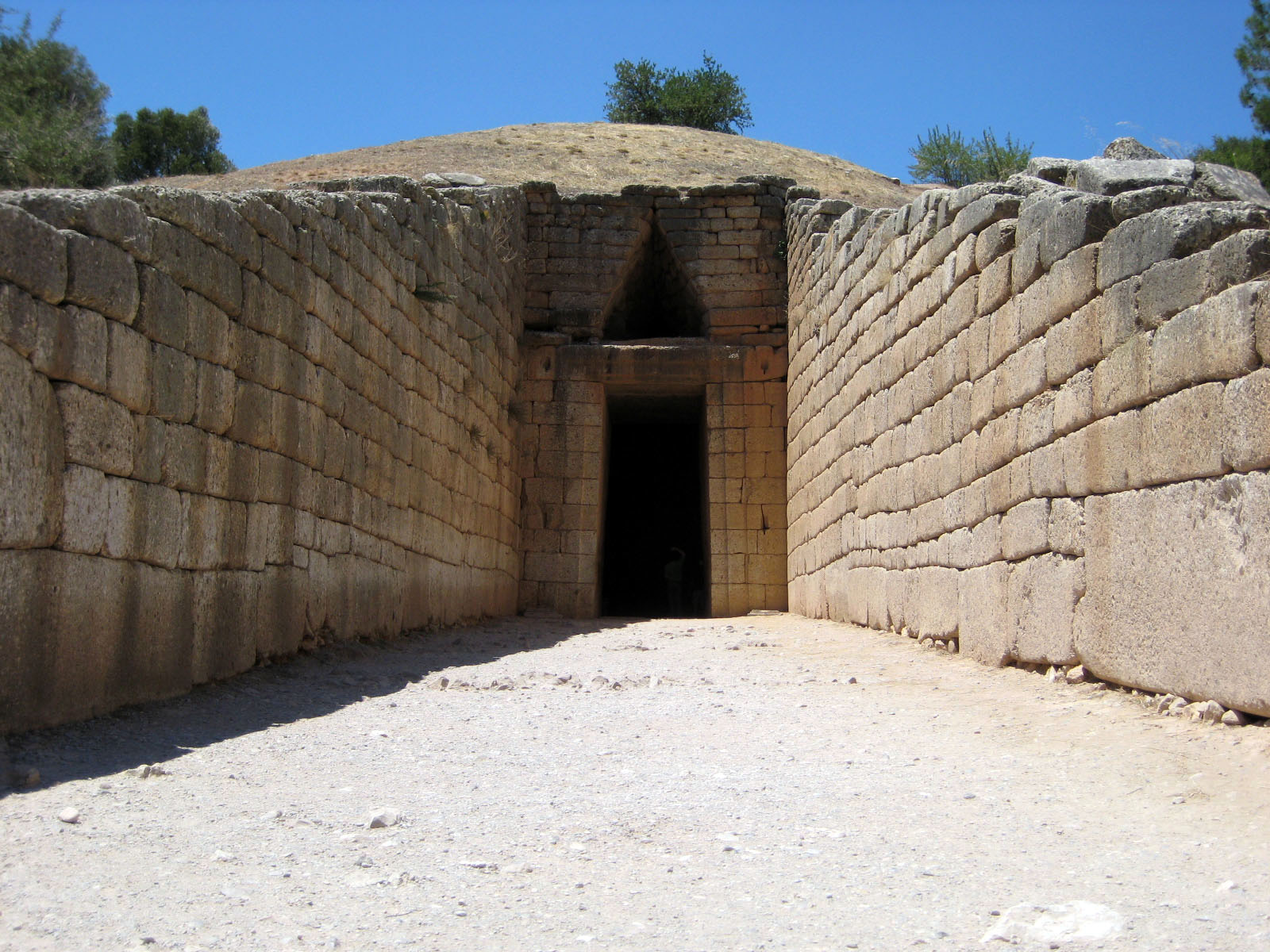 About 500 meters down the road from the main entrance is the “grand piece” of the site known as the “Treasury of Atreus”. When Pausanias, the 2nd century Greek traveler/historian came through, he thought it was so glorious; it must have been built as the treasury, hence the name.
About 500 meters down the road from the main entrance is the “grand piece” of the site known as the “Treasury of Atreus”. When Pausanias, the 2nd century Greek traveler/historian came through, he thought it was so glorious; it must have been built as the treasury, hence the name.
In fact, it’s a tomb. And it was built in the 14th century BC, long before the life of Atreus. There are nine of these giant stone “tholos” or beehive tombs around the Mycenean site. This one is the most complete and the largest. Its massive 3300 year old beehive dome was the tallest and widest in the world until the Pantheon in Rome was built. The interior is almost 48’ high with a diameter of close to 48’. The lintel stone above the 34’ high doorway weighs 120 tons. It’s big.. The red marble plaque that used to sit over the doorway was stolen by the infamous Lord Elgin as he was plundering a path across Greece. The green marble columns that stood on either side of the door are now in the Athens museum. But even stripped down, it’s still a marvel to behold.
There’s a new museum, built on the down slope of one of the hills so you don’t even notice it. It was completed a few years ago and all of the local museums from Nafplio to Argos gave over their collections of photos, pottery, weapons, statues and religious pieces from the dig. When they asked the Athens museum for the Schliemann treasures, you can guess what the response was. Although they do have some good copies of the burial treasure, go to the Athens museum and see the collection there, especially after visiting the site.
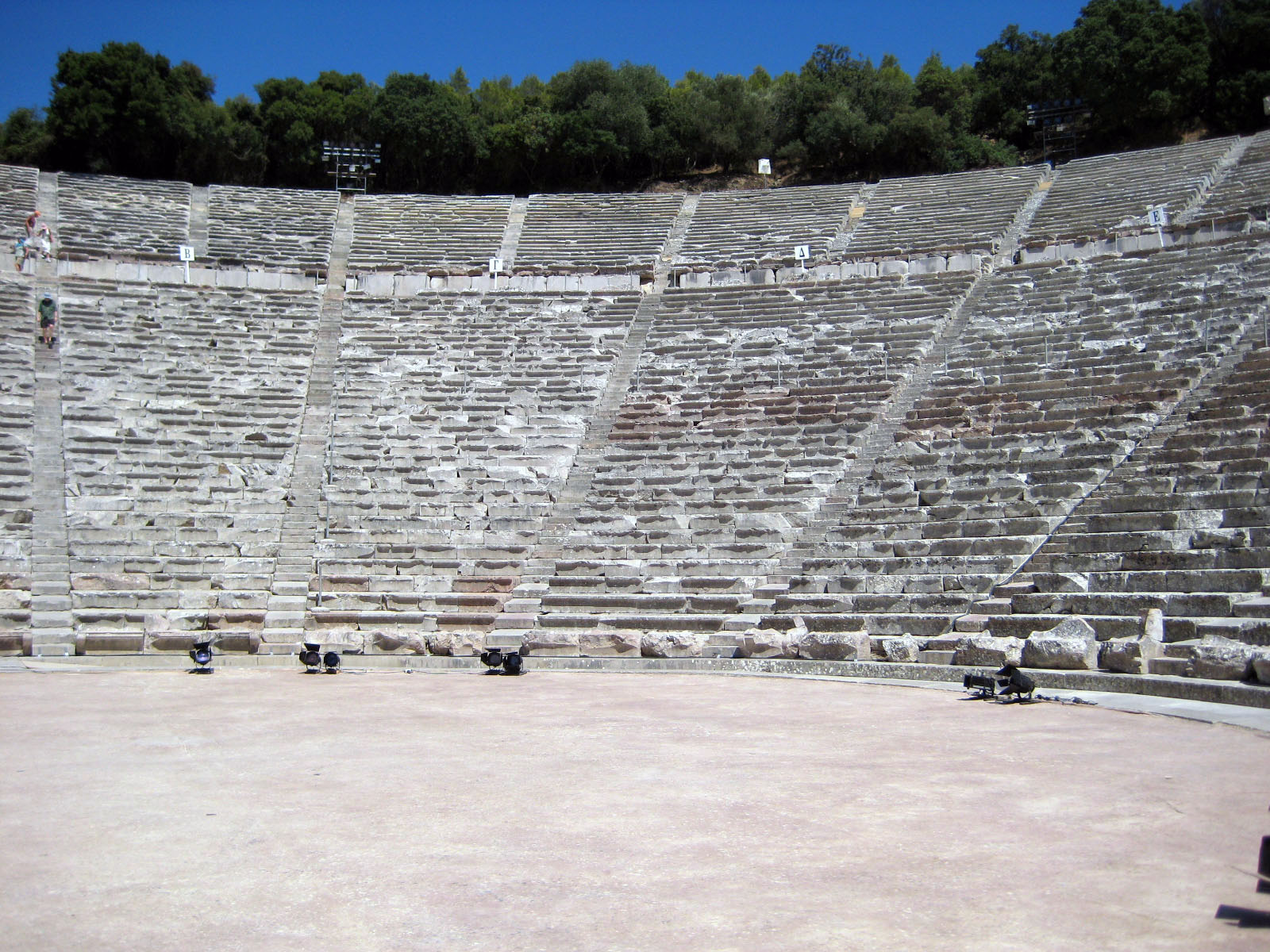 Epidavros
Epidavros
It’s an easy 20 minutes back to Nafplio and another short 20 minute drive to the east to the site of Epidavros. Set in the pine and oleander covered hills, this is another city dedicated to the healing powers of the god, Asklepios. On one side are the ruins of the ancient city and the Asklepeion (the ancient hospital). At the other side is one of the most beautiful Greek theatres in all of antiquity.
When it was originally built in the 3rd century BC it held 3,000 people in 34 rows. When then Romans came in the 2nd century AD, they added 20 more rows for another 3,000. But even with the extra rows, the acoustics are perfect. I spoke in a very normal voice from the center of the floor and Gretchen was able to hear me up on the 34th row. A few minutes later a man in his mid 60s stood on the center disc and sang his High School fight song in full voice. When he finished, people sitting all the way at the top applauded.
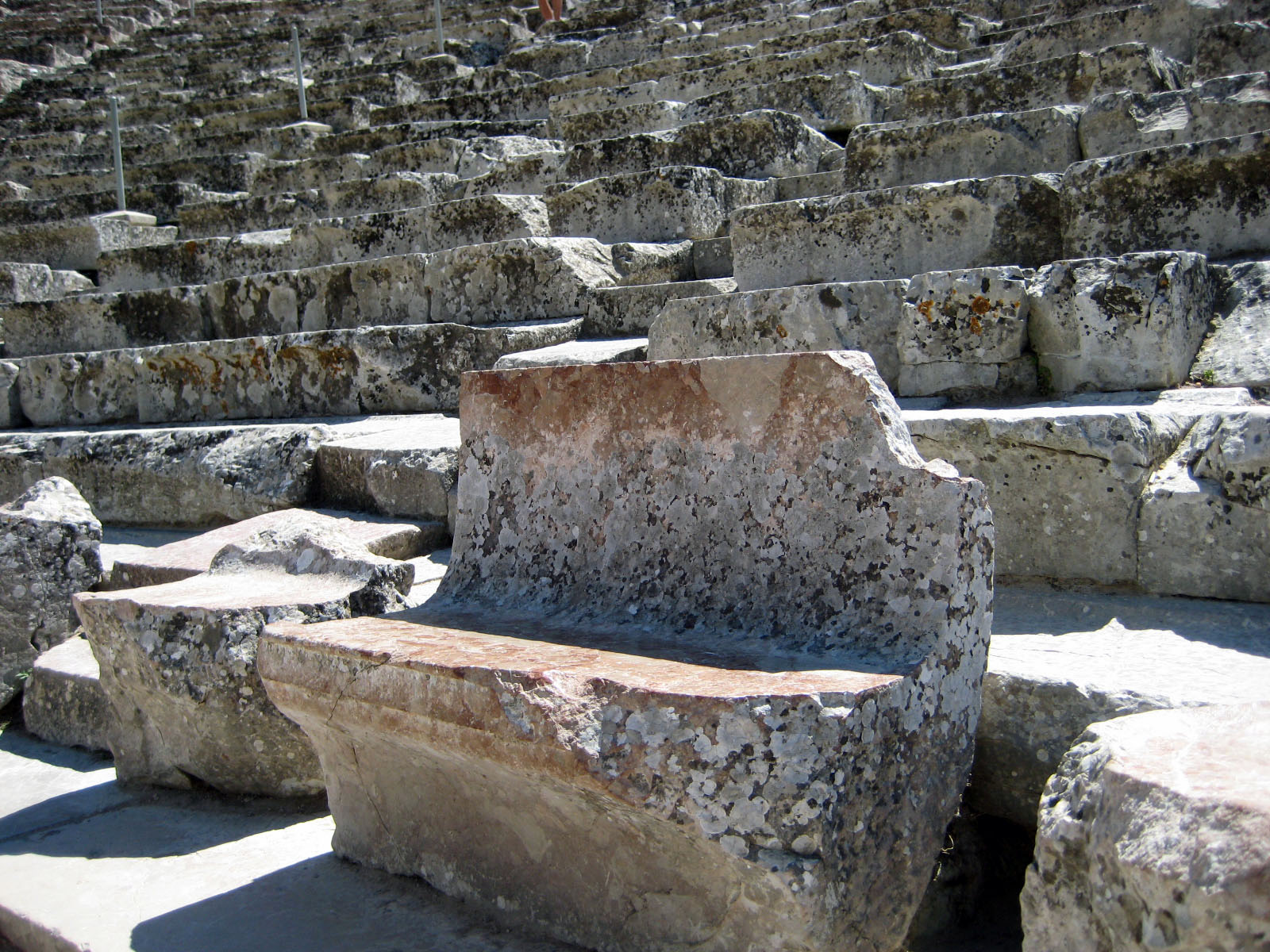 The theatre even had VIP seating; the first and last rows of each section had molded stone backs connected to the seats. The circular orchestra is the only original one in antiquity and still used today. We thought about getting tickets to the National Greek Theatre’s performance of Sophocles’ “Antigone” but it was a fleeting thought. Sitting on stone seats for 3 hours and watching a depressing play about the daughter of Oedipus in Greek? I don’t think so.
The theatre even had VIP seating; the first and last rows of each section had molded stone backs connected to the seats. The circular orchestra is the only original one in antiquity and still used today. We thought about getting tickets to the National Greek Theatre’s performance of Sophocles’ “Antigone” but it was a fleeting thought. Sitting on stone seats for 3 hours and watching a depressing play about the daughter of Oedipus in Greek? I don’t think so.
In ancient times, the Asklepieon here was very famous and visitors came from very far away for supernatural healing. After first going through a purification, the patient would offer an animal to be sacrificed. He would then be shown to a sleeping room in a purified building. During the night, either Asklepias, his snake or his dog would visit the patient in a dream. When the visitor awoke he would tell the priest his dream. The priest would interpret it and give him the proper therapy. In later years, thanks to Hippocrates, Asklepieons became more scientific, moving away from religious mumbo-jumbo dream analysts to more modern techniques, although dream analysts are still popular these days.
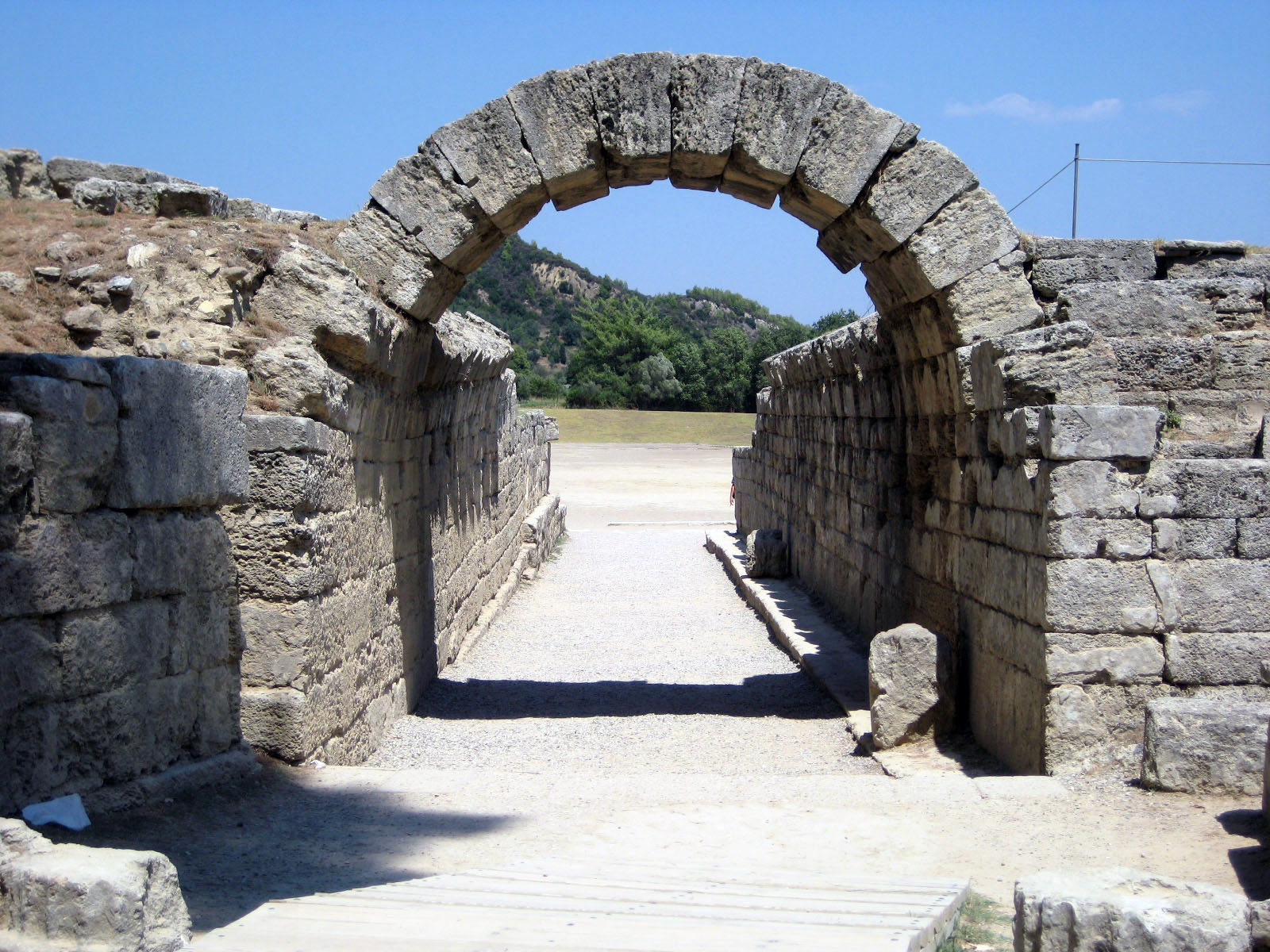 Olympia
Olympia
The ancient city of Olympia is very close to the west coast of Peloponesse, while Nafplio is on the east coast about 160 km away. We thought the drive would take about 1½ to 2 hrs. We were wrong.
When we were in Athens I bought a road map which turned out to be a map of the future. The A5 superhighway shown in the map doesn’t exist yet. The National highways, shown as thick red straight lines have more bends than a cow’s large intestine. And forget about the names of the villages or even the road signs. The village names are spelled differently every time you see them; the Greek spelling in capital letters, the Greek spelling in lowercase and various versions of the names in their western translation. The road signs either don’t exist or some “Yosemite Samos” thought it would be funny to turn them in the wrong direction.
I will admit that many of the views and vistas were unbelievably beautiful and for a while we were very happy on the mountain pass, driving by some villages miraculously suspended off the severe mountain slopes, looking as if a stiff breeze could blow them away. But once we got way up into the Manaion mountains, it all got a little too rural. We started seeing signs to villages that never made it onto our map. We had no idea were we were. There were no cars, no people. For a minute I thought we were going to be lost forever. We’d just turn into local folklore, the silly American tourist who will forever drive through the mountains of central Peloponesse trying to find Olympia.
When we finally found a petrol station and asked for directions. It was unbelievable, we were on the right road. We had just completed 3 1/2 hours of good guessing. About 60 km before we got to Olympia, the road turned into a gravel trail barely big enough for two goats walking abreast. By the time we got to the sign that actually pointed to the site, we still had 5 km on a dirt road.
The first thing I did when we got to the ticket window at the site was to ask the attendant the best way back to Nafplio. She pointed to the same road we took over. I put the map away.
After dusting ourselves off from the 4 ½ hour drive, we climbed out of the car into the 100+° heat and headed into this amazing historical wonder. It’s one of the most peaceful places we’ve ever visited, a beautiful and tranquil setting of pines and oleander. It looks enormous at first glance, but once you get into the site it’s actually easy to navigate.
The Greeks might have declared war on each other for most of the year, but when it came time for the Olympic games, all weapons were laid to rest.
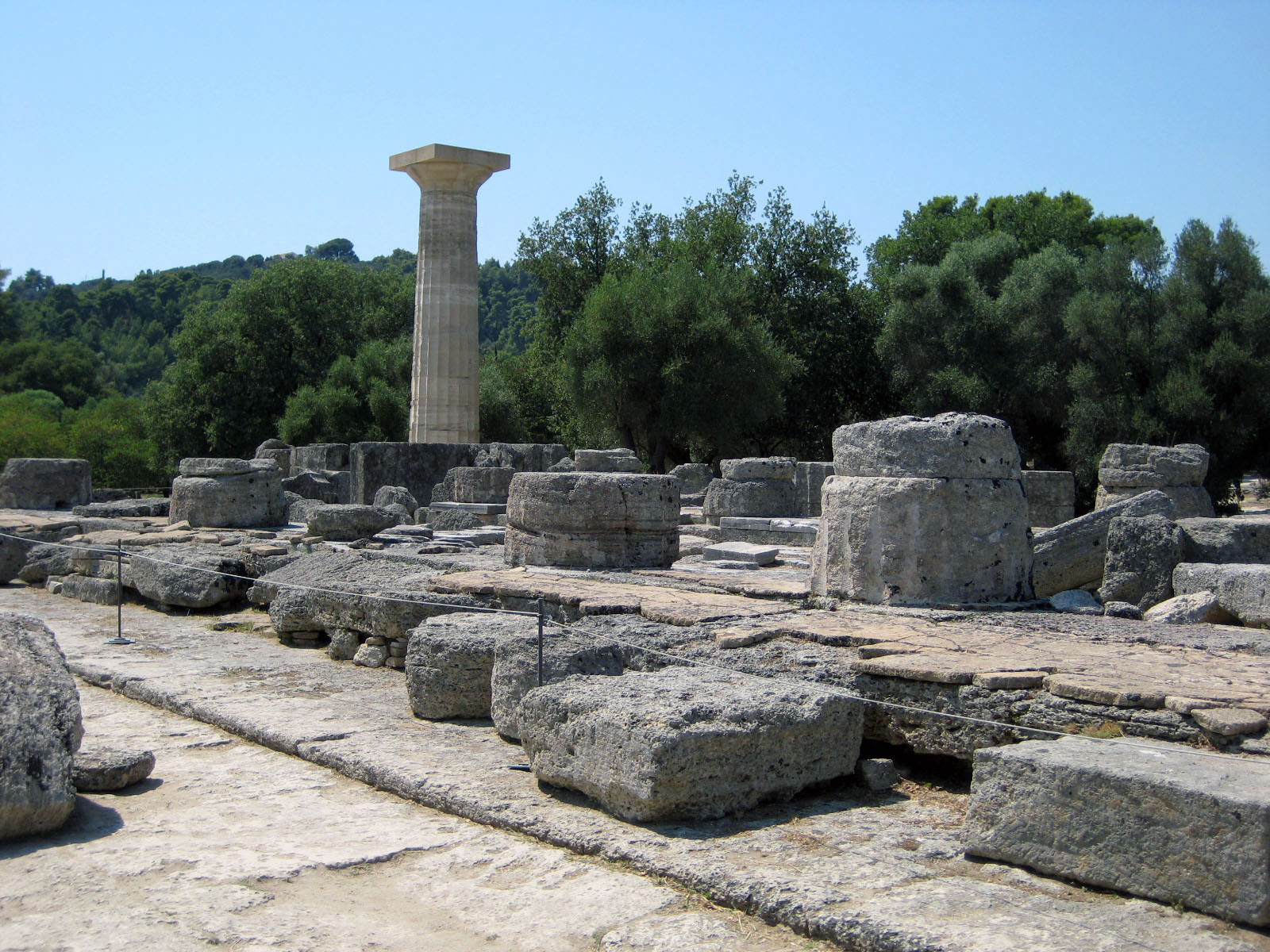 Although the first recorded Olympics weren’t until 776 BC, the cult of Pelops (he was the great charioteer) sprung up here a lot earlier. And although athletes revered Pelops for his athletic ability, the games primarily belonged to the big guy himself, Zeus.
Although the first recorded Olympics weren’t until 776 BC, the cult of Pelops (he was the great charioteer) sprung up here a lot earlier. And although athletes revered Pelops for his athletic ability, the games primarily belonged to the big guy himself, Zeus.
As the story goes, after Zeus killed his father Cronus, he celebrated the victory with the first games, a foot race and a fight to the death. Over the years, the tens of thousands of losers were made into a 22’ high pile of ashes moistened with water, dried and covered with a fresh coat of plaster every year. This was the Alter of Zeus.
In the later years, the games got more controversial. A luxury hotel opened up and then the baths came in. In 338 BC, after Phillip of Macedonia conquered Greece, he built a memorial temple to himself alongside the Temples to the Gods.
In 67AD, the Roman Emperor Nero fixed the games so he’d win everything. He created a special music competition and won. In the 10-horse chariot race, he fell out twice and never finished the race, but he still managed to win.
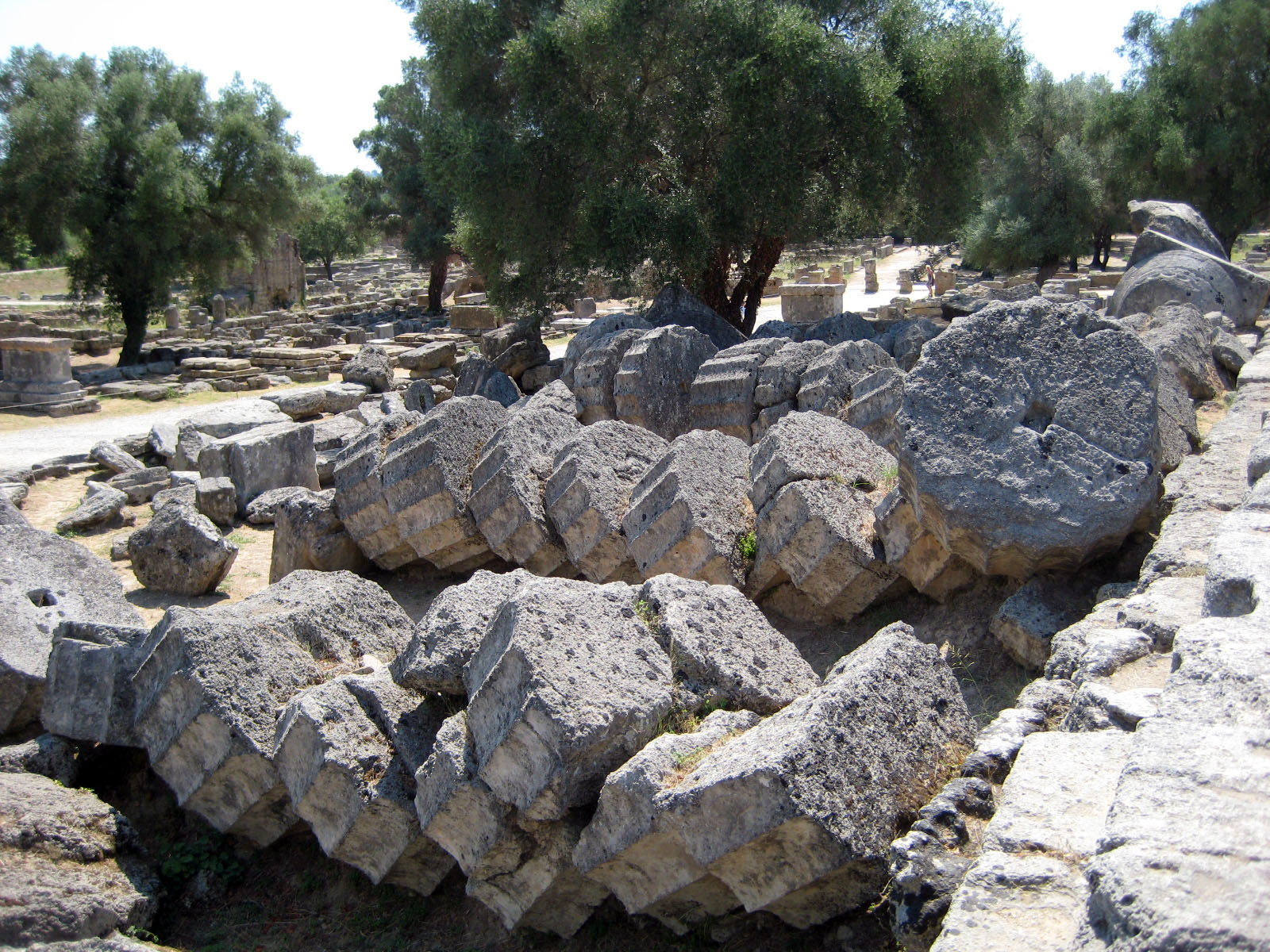 Finally, in 392AD, Theodosius the Great of Constantinople banned the games altogether. They were just too pagan for his Christian tastes. After that, earthquakes and floods knocked down the Olympic site and buried it under 12’ of mud until 1829, when French archaeologists rediscovered pieces from the Temple of Zeus.
Finally, in 392AD, Theodosius the Great of Constantinople banned the games altogether. They were just too pagan for his Christian tastes. After that, earthquakes and floods knocked down the Olympic site and buried it under 12’ of mud until 1829, when French archaeologists rediscovered pieces from the Temple of Zeus.
The Hippodrome is completely gone, washed away from the floods, but the ancient stadium is in perfect condition, right down to the starting blocks and referee box.
 The hills on both sides of the track once seated over 45,000 spectators. The track is 35 yards wide and 210 yards long (on stade in ancient Greek measure). Races went up to 24 stades, sometimes in full armor.
The hills on both sides of the track once seated over 45,000 spectators. The track is 35 yards wide and 210 yards long (on stade in ancient Greek measure). Races went up to 24 stades, sometimes in full armor.
Gretchen sprang from the starting block and hit the track in good stride, even though a German tourist told me she’d have to run a lot faster to compete in the Olympic games. Gretchen replied (after she finished the second stade) “I ran fast enough to finish”. And so she did.
For me, the highlight was the temple of Zeus. The Statue of Zeus is the 3rd of the 7 ancient wonders of the world we’ve seen on this trip and by far the best. The other two were the Temple of Artemis in Ephesus, Turkey and the Mausoleum of Halicarnassus in Bodrum Turkey. The others are just memories but this one still exists (see the two photos above). The columns and alter pieces are laying in segments as if the earthquake that toppled them over just happened.
The temple and the statue were built around 450 BC and when building a temple to Zeus you can’t just fart around with another boring grouping of columns. It had to be bigger and better than any other temple ever built. By the time it was finished, it was 210’ long x 92’ wide with 38 columns, all 33′ tall and all built on a 3’ raised platform. But a temple was just a temple until it had the statue. For this one, the Greeks were able to solicit the aid of Pheidias , the greatest Athenian sculptor of the day. Pheidias happened to be available for the project because he was just run out of Athens after being accused of embezzling gold intended for the statue of Athena and for the impropriety of carving a self portrait onto Athena’s shield.
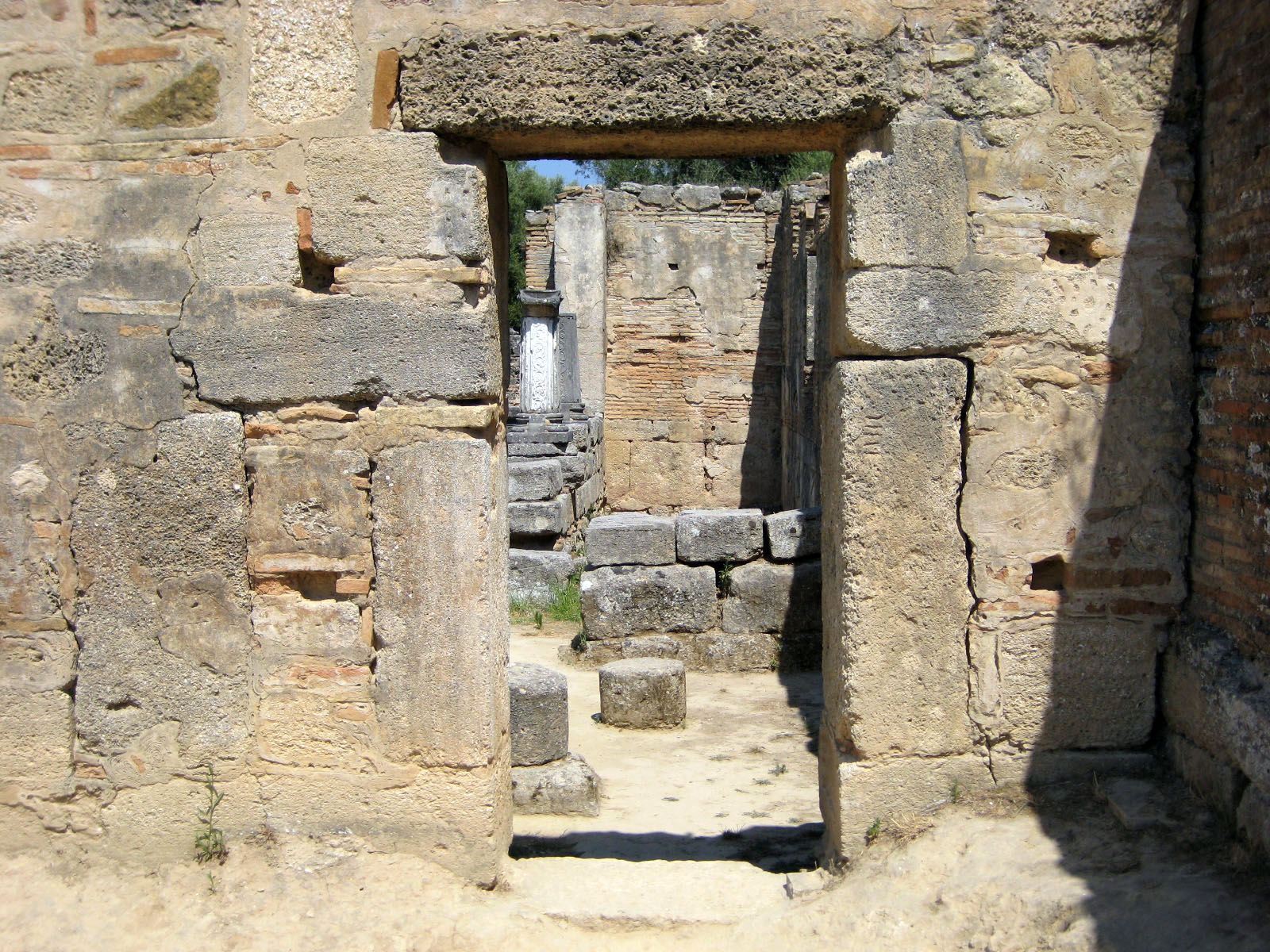 It took Pheidas 10 years to complete the statue. In his workshop next door he built a 43’ wooden frame and covered it with molded sheets of gold and carved ivory and marble. The Statue was crowned with a wreath of olive leaves and the great god held a smaller statue of Nike in his hand (the goddess of victory, not the shoe).
It took Pheidas 10 years to complete the statue. In his workshop next door he built a 43’ wooden frame and covered it with molded sheets of gold and carved ivory and marble. The Statue was crowned with a wreath of olive leaves and the great god held a smaller statue of Nike in his hand (the goddess of victory, not the shoe).
When completed, the Chryselephantine statue barely fit inside the temple. The Greek historian/geographer Strabo commented, “He has shown Zeus seated, but with the head almost touching the ceiling, so that we have the impression that if Zeus moved to stand up he would unroof the temple.”
In the first century AD, the Roman emperor Caligula tried to remove the head of Zeus and replace it with his own, but the attempt failed when the scaffolding built by Caligula’s workmen collapsed.
When Theodosius banned the games in 391 AD, he dismantled the temple and took the statue back to Constantinople. It lasted there for about 70 years before it was destroyed in a severe fire.
The remains of the pediments from the Temple of Zeus are in the Olympia Archaeology Museum. One of them shows a scene commemorating the Chariot race of Pelops and King Oenomios and the marriage of Pelops to Oenomaos’ daughter, Hippodamia. The other side is commemorating the battle of the Lapiths and the centaurs. The Centaurs were invited to the King of Lapiths. All went well till the wine was poured. The Centaurs had never tasted the wonderful brew and as the cups passed, the centaurs got out of control and started raping the women and boys. The Lapiths finally booted the Centaurs out of the party. The moral of the story, don’t give wine to centaurs.
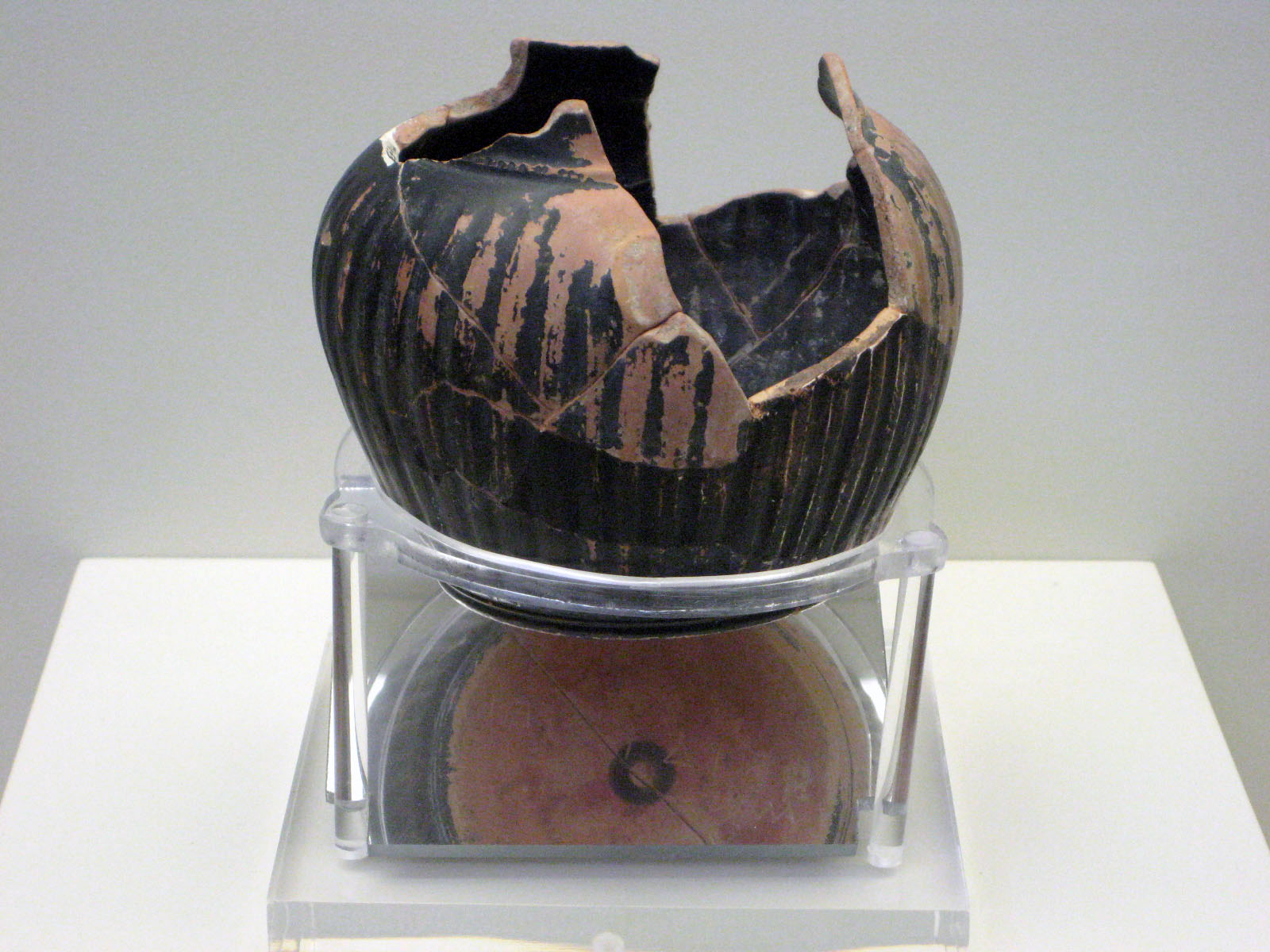 The museum also holds the remains of some friezes of the labors of Hercules, but the real prize is a small cup taken from the workshop of Pheidias. There’s an inscription on the bottom of the cup that reads, “I belong to Pheidias. The display has a mirror under the cup so you (the viewer) are able to see the inscription.
The museum also holds the remains of some friezes of the labors of Hercules, but the real prize is a small cup taken from the workshop of Pheidias. There’s an inscription on the bottom of the cup that reads, “I belong to Pheidias. The display has a mirror under the cup so you (the viewer) are able to see the inscription.
After Theodosius banned the games in 392 AD, it took until 1,504 years before they were brought back. The promoters of the 1896 games wanted to put them in Olympia but by that time the ancient site was too remote. They chose Athens instead.
In the true spirit of the ancient games, Georgios Averoff, a wealthy Greek and benefactor of the 70,000 seat Kallimarmaro stadium, offered the marriage of his daughter to any Greek who could win the 26 mile run from Marathon to Athens. A Greek did win, by the way. Spiros Louis , a postman from the Athens suburbs finished the race in 2hrs and 58minutes. Greek women threw jewelry at his feet as he crossed the finish line. The King of Greece jumped from his viewing box and ran the last lap along side Louis. However, the marriage to the Averoff fortune never happened. Too bad, it would have been a good Greek story.
These days the Olympic athletes worship Nike instead of Zeus.
Even though every one we asked told us the best route back to Nafplio was back the same way we came, we decided to try the alternate route down the western coastline. This was the route the ancient Spartans used to come to the games. Not only was it more relaxing with fewer hairpin turns, it also took 90 minute less. The only obstacle we had was when we got back to the Argolic Gulf, about 6 km from Nafplio. The highway department decided to spray a layer of tar over the road and all traffic was detoured to the beach. We drove on the sand for about 4 km. People were still sunbathing and swimming as they turned and watched the parade of cars drive past their spread towels and opened umbrellas. It was pretty funny.
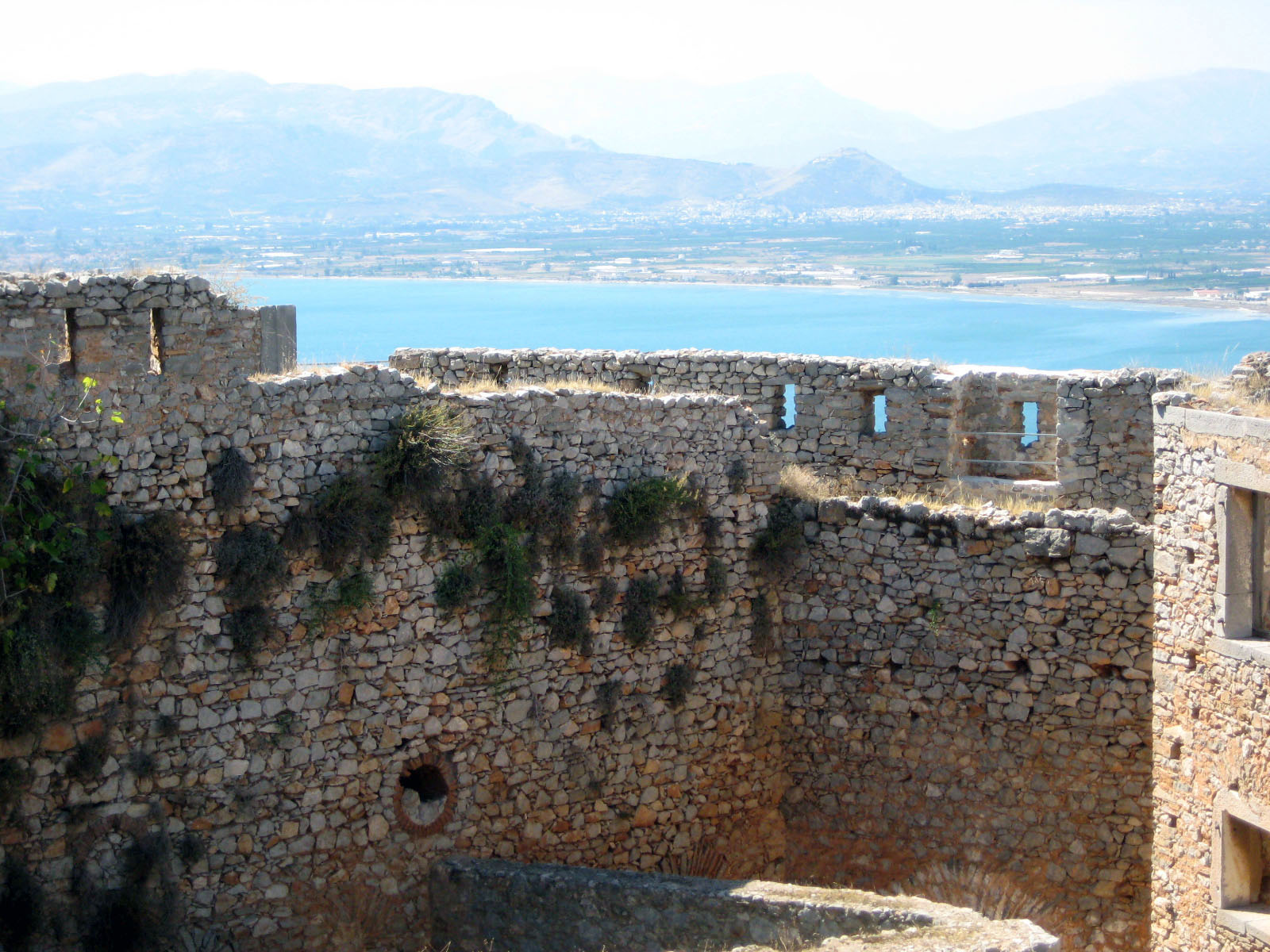 The Palamidi Fortress of Nafplio
The Palamidi Fortress of Nafplio
We spent our last day in Peloponesse in Nafplio. We just can’t get tired of this place. We had a leisurely Greek breakfast while tossing crumbs to our favorite “dancing bird”, a small sparrow that would flutter her wings and shake her head in ecstasy whenever we threw her a few crumbs of a sweet muffin.
We walked through the town, visited a few of the local museums, and then went up to the Palamidi Fortress, high up on the mountain overlooking the bay. There are two ways to get to the fortress. One is climbing up the 999 steps from the Arvanitia Beach, the other is to drive up. The temperature hit 42°C by late morning. We took the car.
 We entered through the eastern gate, the same one the Turks gained access through when a Crusader rat sold out his comrades and turned over the fortress to them in 1715. The views are unbelievable, but then so are most o the views from this part of Greece. We’ve been told it took only 3 years to build the Palamidi complex, but we’re having a real hard time believing it. Just cutting and hauling the stones up here should take more than 3 years. And they didn’t just build one Fortress; there are 3 of them up here. If one fell, everyone would just move to one of the two remaining. They were all well fortified.
We entered through the eastern gate, the same one the Turks gained access through when a Crusader rat sold out his comrades and turned over the fortress to them in 1715. The views are unbelievable, but then so are most o the views from this part of Greece. We’ve been told it took only 3 years to build the Palamidi complex, but we’re having a real hard time believing it. Just cutting and hauling the stones up here should take more than 3 years. And they didn’t just build one Fortress; there are 3 of them up here. If one fell, everyone would just move to one of the two remaining. They were all well fortified.
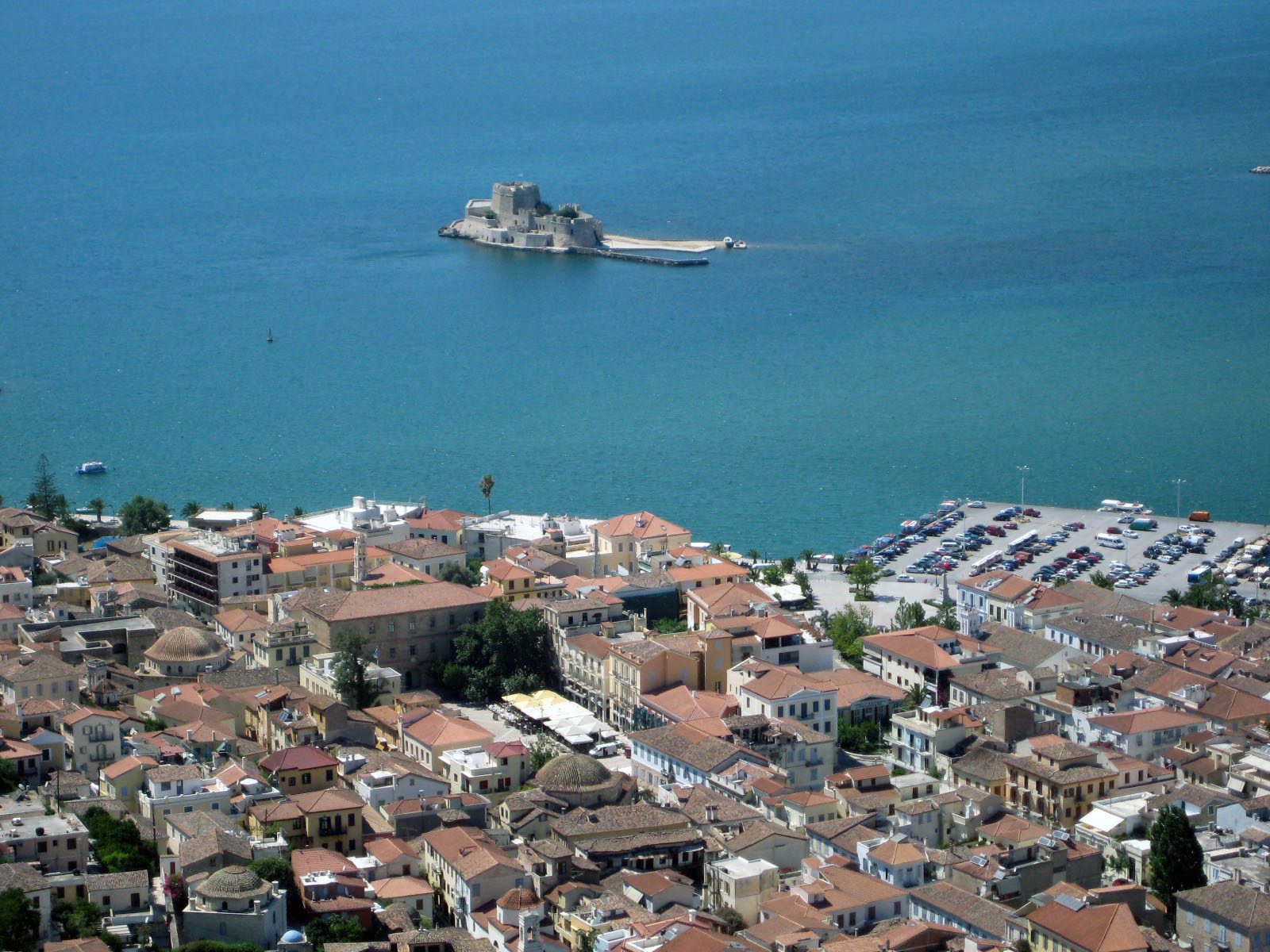 Walking from one bastion to another is a good hike. There are views over the old town, views over the new town, views over the Argolic Gulf and views over the harbor. The ramparts known as Themistocles is where the Ottoman Hasan Pasha tossed the Albanians of Morea off the wall to the beach below, after inviting them in with offers to pay them their due wages he instead gave them the big heave ho over the wall. They beach where they landed (Arvanitia Beach) is now the favorite bathing spot in town.
Walking from one bastion to another is a good hike. There are views over the old town, views over the new town, views over the Argolic Gulf and views over the harbor. The ramparts known as Themistocles is where the Ottoman Hasan Pasha tossed the Albanians of Morea off the wall to the beach below, after inviting them in with offers to pay them their due wages he instead gave them the big heave ho over the wall. They beach where they landed (Arvanitia Beach) is now the favorite bathing spot in town.
Aside from the views, the big attraction is the cell of Theodoros Kolokotronis, a guerilla general who helped liberate Greece from the Ottoman Empire in 1822. After the war, his political enemies had him thrown into a very dark cell in Palamidi. He was sentenced to die for treason, but released when another Turkish invasion threatened Peloponesse.
I can’t tell you how sad we were to leave. The good news is, we’ll definitely be back very soon. We’ve been here for 5 days and only scraped the surface. We never got to Corinth or Sparta. We never ate the “gourounopoulo”, the wild boar of Kalamata. We never went down to the ‘Gibralter” like fortress or the sea caves in Monemvasia . There is so much more history, so many more beautiful beaches and relaxing small villages, and of course, we’ll really miss the warm and sincere Greek people.
Pingback: Rome on Rome » 2009 – Athens; the Acropolis Museum and a trip to Hydra